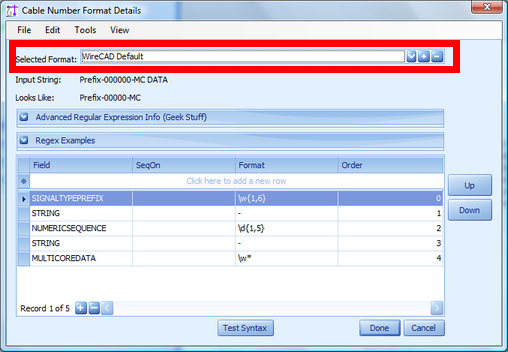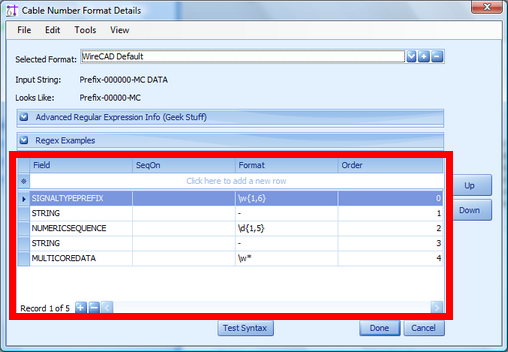|
<< Click to Display Table of Contents >> Cable Number Formatting |
  
|
|
<< Click to Display Table of Contents >> Cable Number Formatting |
  
|
Menu: Project Explorer>Project Databases>Project Cable Number Format
Default command line shortcut: fcab
Related Settings:
None
Allows control of the Cable numbering scheme. Using the Cable Number Format dialog you can select any field that is associated with the Cable Number and concatenate it into your own numbering scheme. Each of the fields selected can be formatted and the numbers can be set to sequence off of another field.
A note on regular expressions: WireCAD makes extensive use of regular expressions (Regex). Regular expressions are a well documented string parsing tool. Much has been written on them. It is not within the scope of this quick start guide to fully explain regular expressions; however, a Google search will tell you more than you ever wanted to know.
Two forms of regular expression are generated: a simplified form that is used as a mask in both the Cables database and in text boxes, and a complex form that aids in the generation of queries to determine the next number in a sequence. The following are both the simplified and complex Regex for the default cable number format:
\w{1,6}-\d{1,5}-\w*
(?<SIGNALTYPEPREFIX>\w{1,6})-(?<NUMERICSEQUENCE>\d{1,5})-(?<MULTICOREDATA>\w*)
|
NOTE: WireCAD supports multiple formats in the same database. In order to accomplish this we use the simplified Regex as a mask. If you have any data in the Project Cables table and you change ANYTHING in ANY Format field you will change the mask and therefore the sequence. You must decide if the change is such that it warrants copying the new simplified Regex to all records in the Project Cables table in order to keep your sequence. |
•Selected Format - Selected the current Cable Number format. Allows addition and deletion of formats as well.

•Variable List - Displays the sequence of variables in grid view that will be concatenated into the final Cable Number.

•SeqOn - This variable should sequence on another variable's value.
•Order - The order in the list of the variable.
•Test Sequence - Performs a basic syntax test on the regular expressions.
Variable |
Description |
Can Sequence On |
Default Format (Regex) |
SIGNALTYPE |
The signal type associated with the cable |
X |
\w{1,4} |
SIGNALTYPEPREFIX |
the signal type prefix associated with the signal type of the cable |
X |
\w{1,4} |
SOURCESYSTEM |
The source SysName |
X |
\w{1,6} |
SOURCEPIN |
The source port or pin name |
X |
\w{1,6} |
SOURCEALIAS |
The source Alias |
X |
\w{1,6} |
SOURCELOCATION |
The source location |
X |
\w{1,6} |
DESTSYSTEM |
The destination SysName |
|
\w{1,6} |
DESTPIN |
The destination port or pin name |
|
\w{1,6} |
DESTALIAS |
The destination alias |
|
\w{1,6} |
DESTLOCATION |
The destination alias |
|
\w{1,6} |
SOURCE_OR_DEST_PIN_IF_JACKFIELD |
Not Yet Implemented |
|
\w{1,6} |
MULTICOREDATA |
Core data as defined in the associated cable type if any |
|
\w* |
STRING |
any string (usually used for delimiters like dashes (-)) |
- |
|
NUMERICSEQUENCE |
a numeric sequence that starts with the project starting number |
\d{1,5} |
|
ALPHASEQUENCE |
an alpha sequence that starts at the letter 'a' |
\w{4} |
|
USER1 |
the global equipment library device definition user1 field |
|
\w{1,6} |
USER2 |
" |
\w{1,6} |
|
USER3 |
" |
\w{1,6} |
|
USER4 |
" |
\w{1,6} |
The Format field uses regular expressions. The following are some simple examples:
\w{1,6} Any non number, non punctuation string from 1 to 6 characters
\w* Any non number, non punctuation string any length
[a-zA-Z0-9]{5} Lower / Upper case and 0 thru 9 exactly 5 characters
\d{1,5} Digits 1 to 5 digits in length
\d* Digits any length
\\ a slash "\". The \ is the escape character so you need two
- a dash except when in [] or {} then a range.
[a-zA-Z0-9_\-\,]{1,4} Lower / Upper case, 0-9, underscore, dash, and comma.